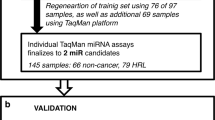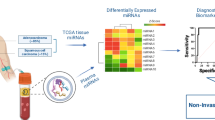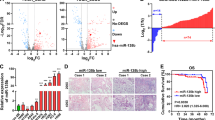Abstract
Aim:
To investigate the expression profile of microRNAs in inoperable advanced non-small cell lung cancer (NSCLC) patients receiving chemotherapy and the potential relevance of microRNAs to clinicopathological characteristics and prognosis.
Methods:
Serum samples were taken from 260 inoperable advanced NSCLC patients and 260 healthy individuals. All the patients received cisplatin-based chemotherapy, including NP/NC regimens, GP/GC regimens, and TP/TC regimens. The serum levels of microRNAs (miR-125b, miR-10b, miR-34a and miR-155) were determined by quantitative real-time PCR.
Results:
Serum levels of the 4 microRNAs examined in NSCLC patients were significantly increased as compared with healthy individuals. The levels of miR-125b and miR-155 were changed in a similar pattern: the patients with stage IV disease had the highest one, while the patients with stage III A and stage III B disease showed similar increased levels. The levels of miR-10b and miR-34a in the patients with different stages were increased to similar extent. The level of miR-125b in poorly differentiated cancer was significantly higher than those in well and moderately differentiated cancers, while the levels of miR-10b, miR-34a, and miR-155 did not significantly differ with cancer differentiation. Among the 4 microRNAs examined, only miR-125b was significantly associated with therapeutic response, exhibiting higher expression levels in non-responsive patients. Furthermore, the high level of miR-125b was significantly correlated with poor patient survival. A multivariate Cox regression analysis showed that the expression level of miR-125b was an independent prognostic marker in NSCLC patients.
Conclusion:
Our results suggest that miR-125b is a potential diagnostic or prognostic biomarker for NSCLC. This finding has important implications for development of targeted therapeutics to overcome chemotherapeutic resistance in NSCLC.
Similar content being viewed by others
Log in or create a free account to read this content
Gain free access to this article, as well as selected content from this journal and more on nature.com
or
References
Neville A . Lung cancer. Clin Evid 2005; (14): 1903–20.
Bernal Bernal R, Leon Jimenez A, Jaen Olasolo J, Benitez Rodriguez E, Mateo Vallejo F . Local recurrence after non-small cell lung cancer surgery: prognosis variables. An Med Interna 2008; 25: 55–60.
Ichinose Y, Tsuchiya R, Yasumitsu T, Koike T, Yamato Y, Nakagawa K, et al. Prognosis of non-small cell lung cancer patients with positive pleural lavage cytology after a thoracotomy: results of the survey conducted by the Japan Clinical Oncology Group. Lung Cancer 2001; 31: 37–41.
Okada A, Hirono T, Watanabe T . Safety and prognosis of limited surgery for octogenarians with non-small-cell lung cancer. Gen Thorac Cardiovasc Surg 2012; 60: 97–103.
Pathak AK, Bhutani M, Mohan A, Guleria R, Bal S, Kochupillai V . Non small cell lung cancer (NSCLC): current status and future prospects. Indian J Chest Dis Allied Sci 2004; 46: 191–203.
Okamoto H, Watanabe K . Medical treatment for stage III non-small-cell lung cancer (NSCLC). Gan To Kagaku Ryoho 2007; 34: 841–8.
Brockmoller J, Junker K, Multhoff G . New perspectives in the management of non-small-cell lung carcinoma (NSCLC). Onkologie 2006; 29: 25–8.
Chang A . Chemotherapy, chemoresistance and the changing treatment landscape for NSCLC. Lung Cancer 2011; 71: 3–10.
Huppi K, Volfovsky N, Mackiewicz M, Runfola T, Jones TL, Martin SE, et al. MicroRNAs and genomic instability. Semin Cancer Biol 2007; 17: 65–73.
Leung AK, Sharp PA . Function and localization of microRNAs in mammalian cells. Cold Spring Harb Symp Quant Biol 2006; 71: 29–38.
Bagnyukova TV, Pogribny IP, Chekhun VF . MicroRNAs in normal and cancer cells: a new class of gene expression regulators. Exp Oncol 2006; 28: 263–9.
Osada H, Takahashi T . MicroRNAs in biological processes and carcinogenesis. Carcinogenesis 2007; 28: 2–12.
Pfeffer S, Voinnet O . Viruses, microRNAs and cancer. Oncogene 2006; 25: 6211–9.
Cortez MA, Welsh JW, Calin GA . Circulating microRNAs as noninvasive biomarkers in breast cancer. Recent Results Cancer Res 2012; 195: 151–61.
Lovat F, Valeri N, Croce CM . MicroRNAs in the pathogenesis of cancer. Semin Oncol 2011; 38: 724–33.
Ng EK, Chong WW, Jin H, Lam EK, Shin VY, Yu J, et al. Differential expression of microRNAs in plasma of patients with colorectal cancer: a potential marker for colorectal cancer screening. Gut 2009; 58: 1375–81.
Wei J, Xie L, Taron M, Rosell R, Liu B . Epigenetic alterations of tumor marker microRNAs: towards new cancer therapies. Drug News Perspect 2010; 23: 655–61.
Yu DC, Li QG, Ding XW, Ding YT . Circulating microRNAs: potential biomarkers for cancer. Int J Mol Sci 2011; 12: 2055–63.
Wang H, Tan G, Dong L, Cheng L, Li K, Wang Z, et al. Circulating miR-125b as a marker predicting chemoresistance in breast cancer. PLoS One 2012; 7: e34210.
Ferracin M, Zagatti B, Rizzotto L, Cavazzini F, Veronese A, Ciccone M, et al. MicroRNAs involvement in fludarabine refractory chronic lymphocytic leukemia. Mol Cancer 2010; 9: 123.
Graziano F, Canestrari E, Loupakis F, Ruzzo A, Galluccio N, Santini D, et al. Genetic modulation of the Let-7 microRNA binding to KRAS 3′-untranslated region and survival of metastatic colorectal cancer patients treated with salvage cetuximab-irinotecan. Pharmacogenomics J 2010; 10: 458–64.
Mathe EA, Nguyen GH, Bowman ED, Zhao Y, Budhu A, Schetter AJ, et al. MicroRNA expression in squamous cell carcinoma and adenocarcinoma of the esophagus: associations with survival. Clin Cancer Res 2009; 15: 6192–200.
Feng J, Sun X, Sun N, Qin S, Li F, Cheng H, et al. XPA A23G polymorphism is associated with the elevated response to platinum-based chemotherapy in advanced non-small cell lung cancer. Acta Biochim Biophys Sin 2009; 41: 429–35.
Yang YQ, Li L, Wang J, Liu XY, Chen XZ, Zhang W, et al. A novel GATA4 loss-of-function mutation associated with congenital ventricular septal defect. Pediatr Cardiol 2012; 33: 539–46.
Kong F, Sun C, Wang Z, Han L, Weng D, Lu Y, et al. miR-125b confers resistance of ovarian cancer cells to cisplatin by targeting pro-apoptotic Bcl-2 antagonist killer 1. J Huazhong Univ Sci Technolog Med Sci 2011; 31: 543–9.
Fujita Y, Kojima K, Hamada N, Ohhashi R, Akao Y, Nozawa Y, et al. Effects of miR-34a on cell growth and chemoresistance in prostate cancer PC3 cells. Biochem Biophys Res Commun 2008; 377: 114–9.
Acknowledgements
This work was supported by Zhejiang Province Welfare Technology Applied Research Program (2011C33051) and the National Natural Science Foundation of China (No 31171024).
Author information
Authors and Affiliations
Corresponding author
Rights and permissions
About this article
Cite this article
Cui, Eh., Li, Hj., Hua, F. et al. Serum microRNA 125b as a diagnostic or prognostic biomarker for advanced NSCLC patients receiving cisplatin-based chemotherapy. Acta Pharmacol Sin 34, 309–313 (2013). https://doi.org/10.1038/aps.2012.125
Received:
Accepted:
Published:
Issue date:
DOI: https://doi.org/10.1038/aps.2012.125
Keywords
This article is cited by
-
Liquid biopsy for therapy monitoring in early-stage non-small cell lung cancer
Molecular Cancer (2021)
-
Epigenetic predictive biomarkers for response or outcome to platinum-based chemotherapy in non-small cell lung cancer, current state-of-art
The Pharmacogenomics Journal (2019)
-
Deregulated miRNAs in osteoporosis: effects in bone metastasis
Cellular and Molecular Life Sciences (2019)
-
Clinical utility of circulating non-coding RNAs — an update
Nature Reviews Clinical Oncology (2018)
-
MicroRNA-125b in peripheral blood: a potential biomarker for severity and prognosis of children with viral encephalitis
Neurological Sciences (2017)



